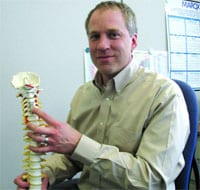Age-weighted Profit Sharing – This Plan May Be a Good Option for Your Medical Practice
Are you among the majority of medical practices that established a retirement plan many years ago and haven’t reviewed it to determine if it is still the best fit? If so, now may be the perfect time to consider a change.
Age-weighted profit-sharing plans have been around for a little over 10 years and are an intriguing tool for the design of retirement plans, permitting employers to make contribution allocations on the basis of age as well as salary. The age-weighted profit-sharing plan can be useful for employers that wish to reward older employees with larger allocations who want contribution discretion, and are willing to give up larger contributions (and pension benefits) available under defined-benefit plans.
The plan may also suit a practice with older and younger partners where the young partners can only afford a limited amount, while the older partners desire contributions near the maximum level. The following is a simple review of how these plans work and a comparison to the plan you may already have.
Service Weighting
Instead of strictly age-weighting a plan, an employer may find it more desirable to reward the longer-service employees by weighting contributions by service, or a combination of age and service, rather than just age. This is a modification of age weighting, since employees with greater service are more likely to be older in age.
The age-weighted profit-sharing plan does not differ in any other respect from the traditional profit-sharing plan. Contributions by the employer can be fully discretionary, Social Security integration is possible, the top-heavy and non-discrimination rules apply, benefits are equal to the account balances, and participant-directed investments are permitted. The contribution limitations are also the same: individual allocations are limited to the smaller of $54,000 (2017) or 25{06cf2b9696b159f874511d23dbc893eb1ac83014175ed30550cfff22781411e5} of salary.
Age-weighted Plans for Self-employed Workers
Age-weighted plans may also be used for self-employed individuals. However, a trial-and-error basis must be used in determining the self-employed individual’s compensation for allocation purposes since it is a circular calculation.
When calculating a self-employed individual’s own contribution deduction to an age-weighed plan, compensation is defined as net self-employment earnings less the deduction for the employer-equivalent portion of the self-employment tax after a reduction for the individual’s own contribution.
If the individual’s compensation after the previous deductions is not reduced below $270,000, the 2017 maximum salary limit for calculating benefits, $270,000 is used for compensation for allocation purposes. However, if the individual’s compensation falls below $270,000 after the necessary reductions, a trial-and-error basis must be used to determine compensation.
Comparing Age-weighted and Other Plans
• Defined-contribution Plans: The money-purchase plan is a defined contribution individual account plan similar to a traditional profit-sharing plan, except that up to 25{06cf2b9696b159f874511d23dbc893eb1ac83014175ed30550cfff22781411e5} of the total salary of participants may be contributed and the company’s contributions are neither discretionary nor flexible. The target-benefit plan is a money-purchase plan where the contributions are age-weighted.
The target plan has been around a long time, but never really caught on because of the requirement of an annual contribution and the $54,000 maximum.
• Defined-benefit Plans: The age-weighted profit-sharing plan resembles the defined-benefit plan in that the contributions are actuarially structured. However, there is a world of difference.
The defined-benefit plan contribution, for instance, is not limited to specified percentages of salary — the limitation is in the annual pension benefit instead. A contribution for a highly compensated older participant can be well in excess of the greater of $54,000 or 25{06cf2b9696b159f874511d23dbc893eb1ac83014175ed30550cfff22781411e5} of salary, and the company contribution in total is not restricted to 15{06cf2b9696b159f874511d23dbc893eb1ac83014175ed30550cfff22781411e5} of total participants’ salary.
The age-weighted profit-sharing plan will produce larger contributions for the older employee and do a better job of providing an adequate pension benefit than the standard profit-sharing plan. However, the defined-benefit plan remains better suited for this purpose, since it can easily relate the pension at retirement to final average pay and total service, and there are no contribution limitations to prevent it from doing so, assuming the necessary funds are available.
Where there are older employees, including the owner, who wish to retire, the defined-benefit plan can provide an adequate benefit level.
Also, contrary to popular belief, the defined-benefit plan can offer contribution flexibility, permitting a certain amount of budgeting by an employer. This usually occurs where there is a past service liability and maximum contributions are made whenever possible, thereby reducing the minimum contribution requirement in succeeding years and expanding the contribution range.
This degree of flexibility does not, of course, approach the complete contribution discretion possible under a profit-sharing plan, but frequently satisfies the employer.
The defined-benefit plan has been saddled with a host of complex requirements generated by the IRS, the Department of Labor, the Pension Benefit Guaranty Corp., and the FASB. As a result, defined-benefit plans are, on average, harder to administer and require greater use of professionals — actuaries, accountants, and, from time to time, attorneys.
The administrative cost will usually be higher than for a profit-sharing plan, unless the profit-sharing plan is encumbered by additional administrative details, such as permitting the participant to select investments from several funds, making loans, and frequent distribution of statements to participants. The employer may also need to pay premiums to the PBGC, which are not required of profit-sharing plans.
The defined-benefit plan, therefore, requires a higher degree of commitment than does an age-weighted profit-sharing plan but, if properly communicated, will usually generate greater goodwill among the older and longer-service employees because of a promised benefit level geared directly to salary and service.


Comments are closed.